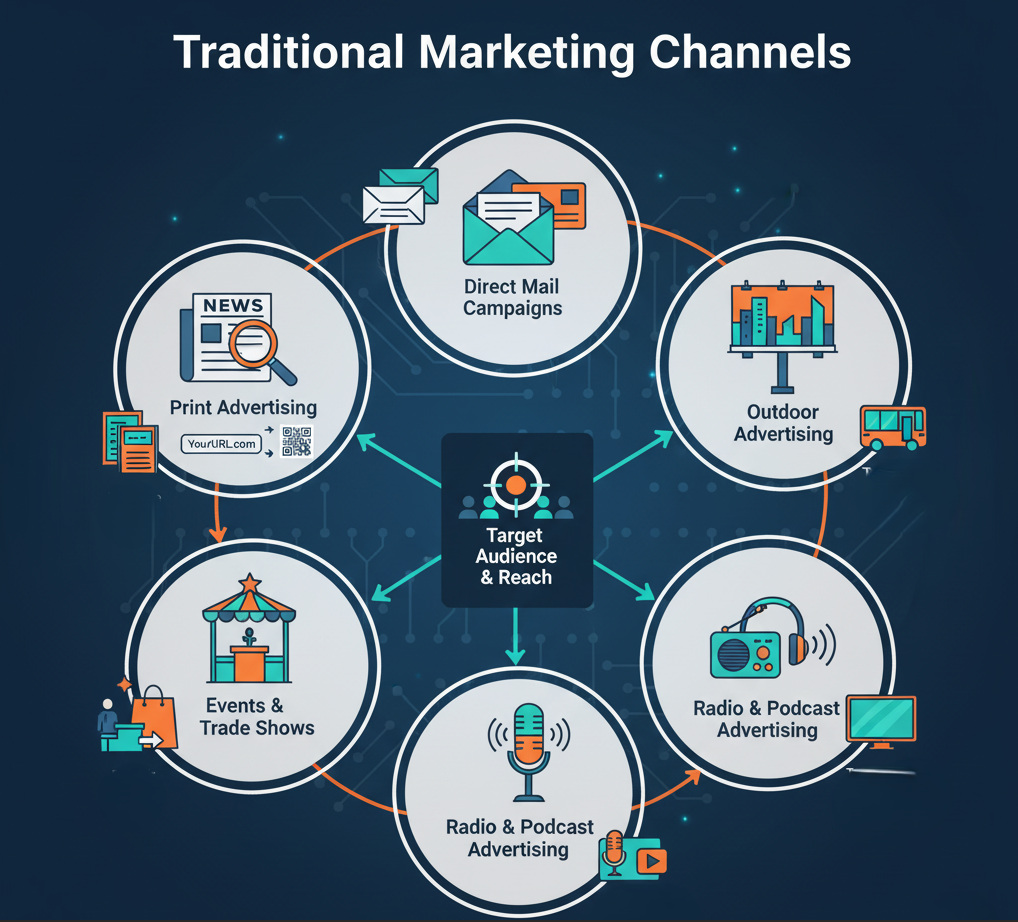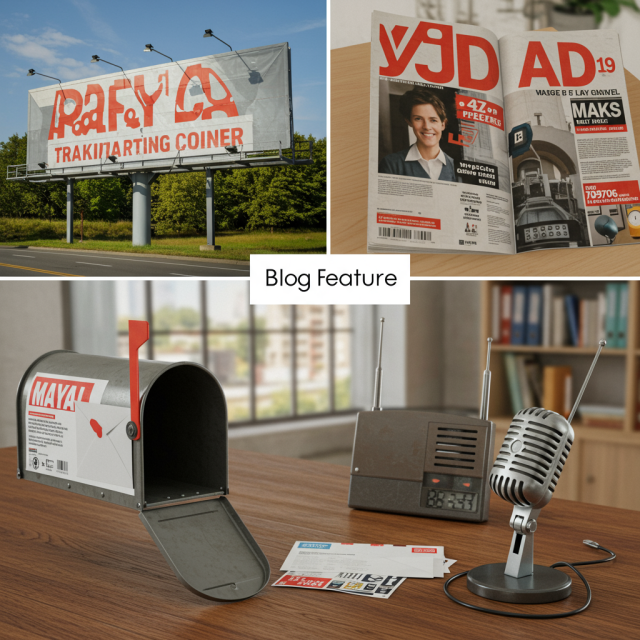In a world increasingly dominated by digital media, traditional marketing remains an essential force for brands seeking to stand out. While online channels such as social media and search engine advertising provide unparalleled targeting and measurability, offline tactics offer tangible experiences, emotional resonance, and credibility that digital alone often fails to deliver. In this comprehensive guide, we’ll explore proven traditional marketing strategies, demonstrate how to integrate them with digital efforts, and provide actionable steps to drive brand awareness, customer engagement, and long-term growth across diverse audiences.
1. Why Traditional Marketing Still Matters
Despite the rapid rise of online advertising, traditional marketing channels continue to command significant consumer attention. Industry surveys show that 70 percent of consumers trust print ads more than digital banners, and 65 percent recall outdoor ads seen during their daily commute. These channels deliver face-to-face or real-world interactions, reinforcing brand legitimacy and creating memorable experiences. Especially for local businesses, community events, and B2B enterprises, offline tactics can foster deeper trust, drive foot traffic, and reach demographics less active online, such as seniors or niche hobbyists.
2. Key Traditional Marketing Channels

2.1 Print Advertising
Print media—including newspapers, magazines, brochures, and flyers—remains a cornerstone of offline marketing. High-quality print ads convey professionalism and permanence. Consider these best practices:
- Select publications with readership demographics that match your target audience.
- Invest in premium placements, such as full-page spreads or Inserts, to maximize visibility.
- Use minimal text, striking visuals, and clear calls to action to guide the reader’s next step.
- Leverage QR codes or vanity URLs to bridge print and digital, enabling precise response tracking.
2.2 Direct Mail Campaigns
Highly targeted and customizable, direct mail remains one of the highest-ROI channels. By leveraging demographic data, you can send personalized catalogs, postcards, or product samples directly to prospects. Optimize your mailers by:
- Segmenting audiences by purchase history, geography, or interests for tailored messaging.
- Testing different formats—postcards, self-mailer letters, dimensional mailers—to see which garners the best response.
- Including trackable elements like promo codes, QR codes, or NFC tags to measure engagement.
- Timing mail drops around key dates or seasonal events to capitalize on consumer intent.
2.3 Radio and Podcast Advertising
Audio marketing offers repeat exposure in everyday environments—cars, homes, and workplaces. Radio ads still dominate local markets, while podcast sponsorships allow brands to reach niche, highly engaged audiences. To maximize impact:
- Craft concise, compelling scripts that highlight a single core benefit.
- Use professional voice talent and high-quality production to build credibility.
- Synchronize ad spots with peak listening times, such as morning and evening commutes or popular podcast episodes.
- Provide unique promo codes or dedicated landing pages to track conversions and ROI.
2.4 Outdoor Advertising
Billboards, transit shelters, bus wraps, and digital out-of-home (DOOH) screens offer continuous brand exposure in high-traffic areas. Effective outdoor advertising requires bold visuals and succinct messaging. Follow these guidelines:
- Keep text under seven words and use contrasting colors for readability at speed.
- Select locations based on traffic flow, competitor proximity, and audience demographics.
- Explore programmatic DOOH to swap messages dynamically based on time of day, weather, or audience data.
- Complement with geofenced mobile ads to retarget commuters who pass your billboards.
2.5 Events and Trade Shows
Live events provide unparalleled opportunities for immersive brand experiences. Whether you’re exhibiting at industry trade shows or sponsoring local community fairs, face-to-face interactions drive trust and generate high-quality leads. Elevate your presence by:
- Designing interactive booths with product demos, virtual reality setups, or gamified experiences.
- Offering branded giveaways that attendees will use beyond the event point of contact.
- Collecting attendee data ethically through digital check-ins or scan badges for post-event follow-up.
- Hosting breakout sessions or workshops to position your brand as a thought leader.
3. Crafting an Effective Traditional Marketing Strategy
Begin with clear, measurable objectives—brand awareness, lead generation, or sales lift. Conduct thorough market research to understand customer profiles, local media consumption habits, and competitor activity. Then, build a campaign plan that includes:
- Channel selection based on audience touchpoints and budget allocation.
- Creative development guidelines to ensure consistent branding and messaging.
- A media schedule outlining timing, frequency, and duration for each tactic.
- Performance metrics and attribution methods for ongoing optimization.
4. Integrating Traditional and Digital Marketing

Synergy between offline and online channels amplifies your impact. Bridge the gap by embedding digital triggers into physical media. For example:
- Include QR codes in print ads that link to interactive landing pages or exclusive offers.
- Embed NFC tags in mailers for instant mobile engagement without app downloads.
- Record radio spots that direct listeners to social media contests or hashtag campaigns.
- Coordinate outdoor ads with location-based mobile ads to retarget viewers later online.
This blended approach not only enhances user experience but also unlocks richer data for audience segmentation and campaign refinement.
5. Measuring Success: Metrics and ROI
Unlike digital analytics, offline measurement demands creativity and rigorous planning. Establish unique identifiers—promo codes, dedicated phone numbers, custom URLs—for each channel. Then track:
- Redemption rates on printed coupons or direct mail offers.
- Call-in volumes and web traffic spikes during radio or outdoor ad flights.
- Event-driven sales and post-show meeting requests at trade conferences.
- Customer surveys and attribution models ask, “How did you hear about us?”
Calculate ROI by comparing incremental revenue against production, placement, and distribution costs. Use A/B tests across different formats and messages to identify top performers and inform future budget allocations.
6. Case Studies and Real-World Examples
A regional restaurant chain increased weekend reservations by 25 percent after distributing targeted direct mail postcards featuring limited-time menus and a QR code for instant bookings. A B2B software provider leveraged a magazine advertorial series combined with whitepaper mailers to generate a 40 percent uptick in qualified leads. Meanwhile, a local theater saw a 30 percent jump in ticket sales when they partnered with a popular radio station for live interviews and on-air giveaways. These examples highlight the enduring power of well-executed traditional tactics.
7. Future Trends in Traditional Marketing
Traditional channels are evolving with technology. Variable data printing enables hyper-personalized mailers tailored to individual preferences. Programmatic DOOH lets you buy and optimize billboard inventory in real time, swapping messages based on audience demographics, weather, or traffic patterns. Hybrid events blend in-person and virtual components, extending reach and engagement. Brands that embrace innovation—blending automation, data analytics, and creativity—will keep traditional marketing at the forefront of their growth strategies.
8. Conclusion
Traditional marketing remains an indispensable pillar of a holistic marketing strategy. By understanding the unique strengths and best practices for print advertising, direct mail, radio, outdoor media, and events, you can craft immersive brand experiences that resonate across generations. Integrate these tactics seamlessly with your digital campaigns to enhance measurability and ROI. In doing so, you’ll revitalize your brand presence, foster deeper customer connections, and drive sustainable growth for years to come.
Learn more about: The Resurgence of Print Marketing: How to Drive ROI with Direct Mail









